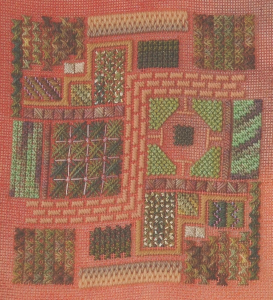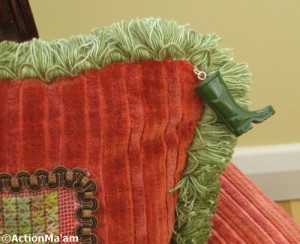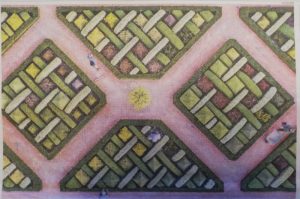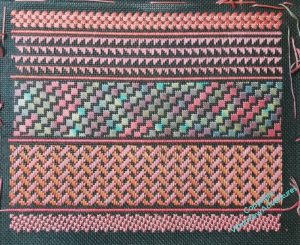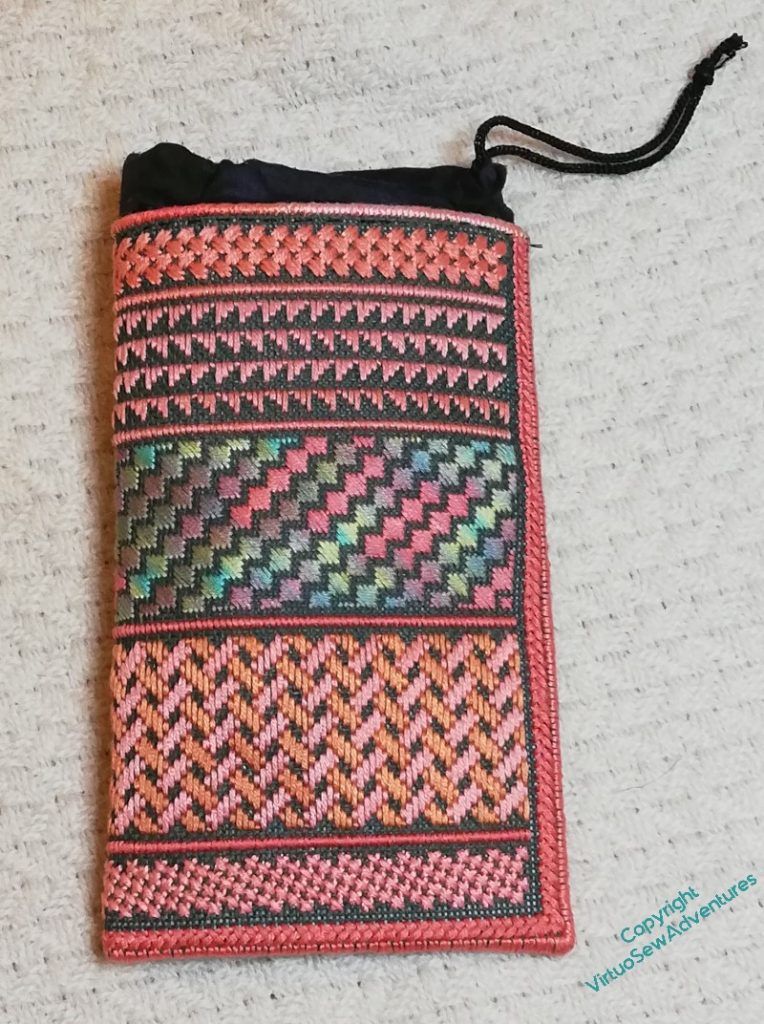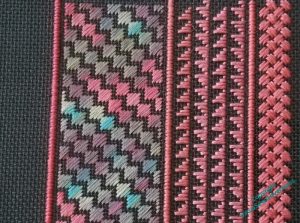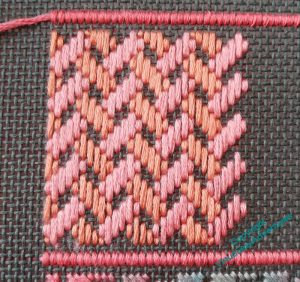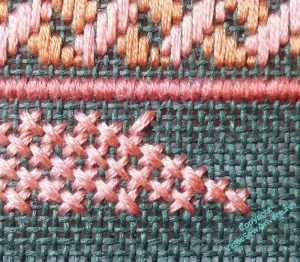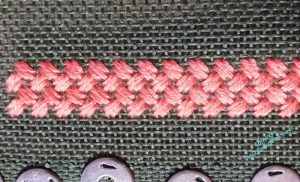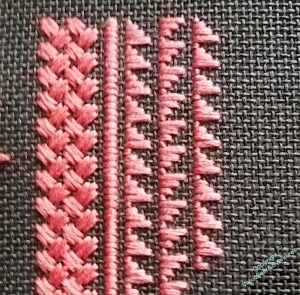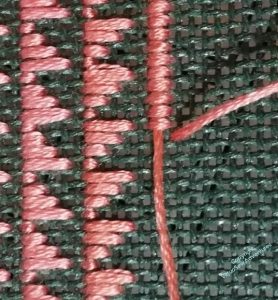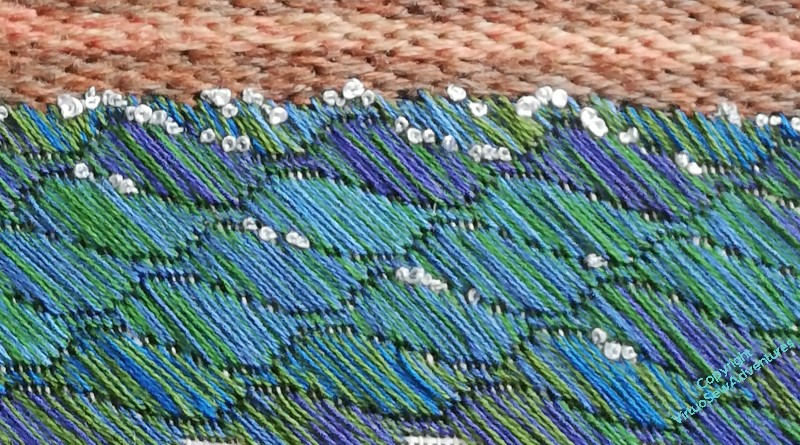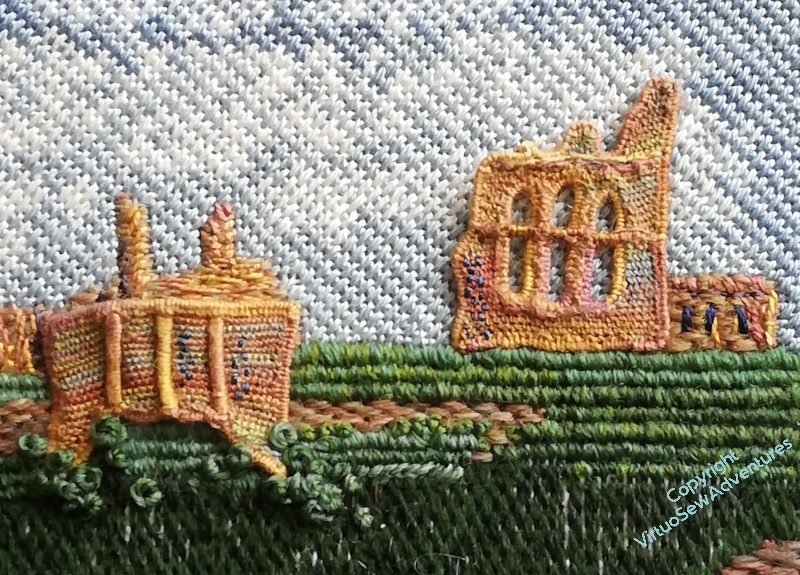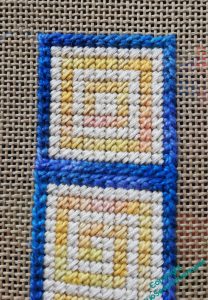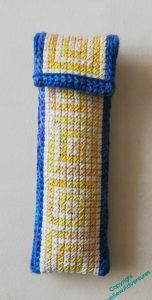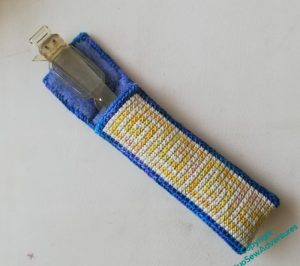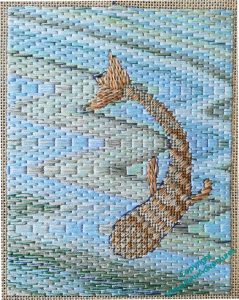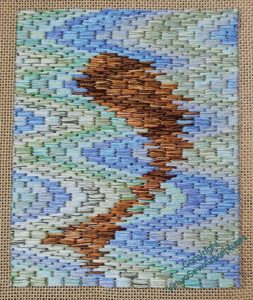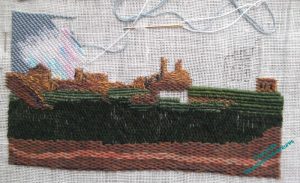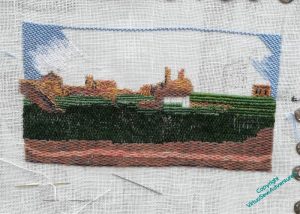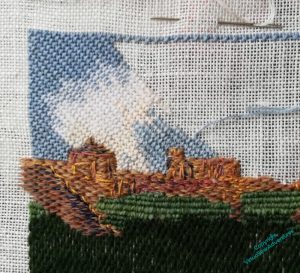Tag: Needlepoint
Another new project to think about
Remember this? It was an exploration of canvaswork, a very long time ago, and when I’d finished it, I hadn’t the vaguest idea what to do with it. Then my cousin said she knew exactly what to do with it, and could she have it, please?
She and her local soft furnishing people turned it into a rather fabulous cushion, and it has been sitting happily kicking welly-booted heels in the air on a chair in her conservatory ever since.
Fast forward to some recent reorganising in her house, and she has a another chair that might be interested in a companion piece. Not the same shape, and not the same canvas, fortunately, and not necessarily the same colours either, just similar. I have to find the canvas before I can get excited about this one, so it will be a while, but I do have something to think about.
My cousin found a gorgeous drone shot of a knot garden in a National Trust property, and said “Start from this!”. The central tree might even end up as a sculpted piece of one of the pile stitches – that would be fun, wouldn’t it!
I’m thinking I might choose to use a brown canvas this time, and use as many variegated greens as I can lay my hands on. But as I’m not sure where I’ll find the canvas, my ideas have plenty of time in which to change….
Finishing my canvaswork sunglasses case
So in due course I had finished the coral canvaswork panel, and took it off the frame. Then I had a slight anxiety about the size, and whether there would be space to go all around the sunglasses, and went around three sides with herringbone stitch.
The herringbone stitch rather emphasised the unevenness of one of the sides, but I’m choosing not to mind that, especially as the herringbone stitch had a secondary task; that of attaching some padding fabric to the the back of the canvaswork.
The fourth side was also herringbone stitch, but in that case, it’s the herringbone edging I often use on canvaswork pieces to cover and strengthen edges.
The finished piece was just folded in half and satin stitched to join the edges together. I didn’t herringbone it in this case because it was becoming so very difficult to stitch!
Finally, I took one of those flimsy black fabric cases that you sometimes get with a pair of sunglasses, and stitched it in around the top edge. Lovely though it is to have a bright, strong case for sunglasses, it’s not remotely protective if they keep falling out, and the drawstring will ensure that they stay put.
Now all I need is sunglasses weather!
Continuing the Exploration
The next panel, I decided, needed a little more variation in colour. The thread is a 12-strand overdyed stranded cotton from Stef Francis, and I’ve had it for so long (like the canvas) that I don’t know when I got it or what I had in mind for it at the time!
The stitch is Moorish Stitch, and again it is voided, leaving unstitched the row of tent stitches that alternate with the larger stitches under normal stitches.
I went back to Jo Ippolito Christensen for the next stitch, Medieval Mosaic Stitch, and with the alterations I made it looks most unexpected. As diagrammed, it is almost a variation on Florentine stitch, with a thick-and-thin ribbon of stitches running across the piece. In choosing the section to void, I picked the two small stitches that form the “thin” part, and as a result, that element has been completely obscured, and it looks like a classical woven pattern. That effect is enhanced by the fact that I picked two shades of coral to use up, hoping that they’d last to the end if they shared the burden. They did!
At this point, I think I have nearly enough stitched to make the sunglasses case I hope for, so I have mirrored the first section with another that leaves only one crossing-point voided. This is Staggered Crosses, and under normal circumstances there would be two different sizes of cross stitch contrasting with one another. I rather like this version, though!
Now I need to work out what form the glasses case will take, and what colour I’m going to back the canvas with, since it’s going to show…
Something that Wants Finishing..
Being known as a stitcher leaves one heir to everything stitch related that someone, far or near, may be at a loss to deal with. Sometimes this is a thrill, sometimes it’s a chore, sometimes a bewilderment.
I’m not sure what I’m going to do with this, passed on to me by a friend of a friend. Almost all you can see below is already finished, and I’m certainly not going to undo it.
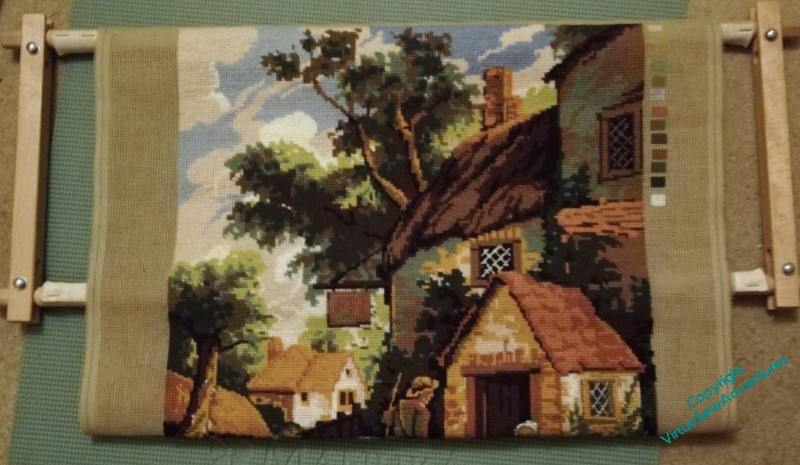
But what follows isn’t finished, and I don’t have the threads that came with the canvas.

First thoughts are to unpick anything of the people and animals that’s been stitched, and restitch it with stranded cottons, maybe slightly more highly coloured. Then perhaps do the ground in a mixture of soft cottons and tapestry wool, although those muted, sludgy colours may be a little hard to find in my stash.
Thoughts, anyone?
An exploration
I’ve had this piece of forest green canvas for so long, I can’t remember where it came from, and since my instinct with canvas is always to cover it completely, I’ve been at rather a loss as to what to do with it. Then I realised that a rather nice pair of sunglasses lack a case, and decided to Explore.
The recent ebay purchase of the much-recommended “The Needlepoint Book” by Jo Ipplolito Christensen (which gave me the river below Tynemouth Priory) has given me a starting point. This is Criss Cross Hungarian Stitch, and the single crossing thread is intentionally left unstitched, which has given me my next theme: each section will involve leaving void some portion of the pattern. After all, that dark green makes a lovely foil for all the coral, doesn’t it!
The second block is named “Wild Goose Chase”, and there are a variety of ways I could have chosen to alternate stitching and voiding on this one. I think the one I chose in the end allows for a slightly smaller pattern block, and that, in turn, should protect the canvas. I am assuming that the stitch is named for, and inspired by, a quilting pattern.
I’m using a variety of elderly stranded cotton which came from a great aunt, so although I am going to try to keep to one shade per section, I’m not going to lose sleep over it if it becomes a bit of a hotchpotch!
Which is just as well, because the very next row ended up in a slightly darker shade of coral than the previous one!
I’m also separating each band of stitching with a row of satin stitch, but an effort to even out the different coverage of the various threads, it is satin stitch padded with an unseparated stranded cotton.
There’s something very pleasing about the coral against the green. I’m enjoying this!
Finishing Tynemouth Priory
I’m a little behind with posting this, but there were a few details to finish off-video…
I didn’t want to overdo the water, but I wanted to break up the pattern a little, to create the sense of foam on the surface. I’ve used French Knots, in white silk and very very pale blue single strands of cotton. There were more, but having put them in, I took them straight out again!
Finally, I got to add in the two needlelace slips. I hope you can see that I’ve added a few green French knots to help one section to bed in nicely.
The other one, I’ve twisted and pulled a little, and I’ve tried not to stitch it down too firmly or in too many places. I want the shadow of the slip to help create the sense of distance and disintegration, and I think it’s turned out rather well. I did jam it up hard against the rows of raised satin stitch, and again, I had to be a bit careful, to make sure I didn’t pull those stitches through to the back.
Finally, the first attempt at Tynemouth Priory for “Leaving the Tyme 1915”, finished in its own right. I suspect that when I frame it, I will crop at least some of the water out, but for sure, as I said in the video, adding it in if you didn’t do enough the first time becomes really, really trying.
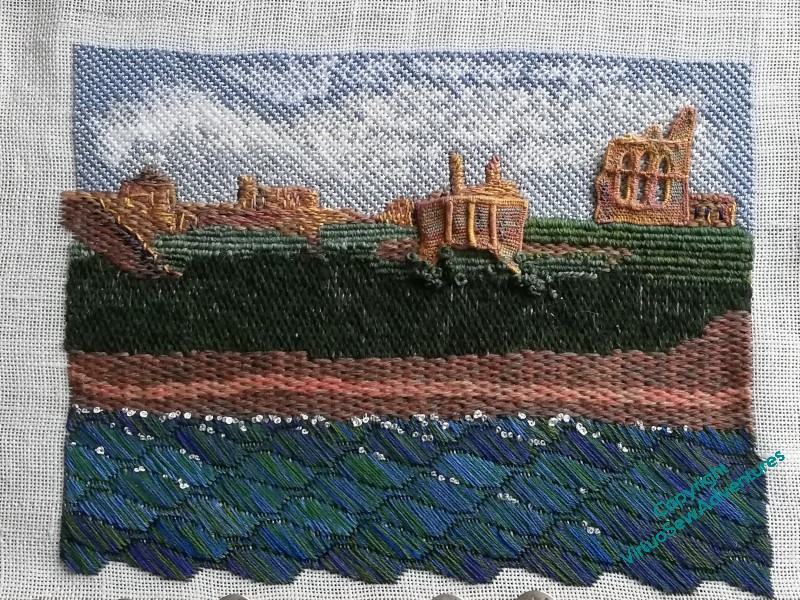
As you know, I don’t feel comfortable planning to the last detail before I stitch. I like to have space to explore and experiment. That in turn means I have to be comfortable tweaking how I work and how I display what I’ve done, and it is often the case that embroidery responds to close mounting in a way that watercolours, for instance, do not. I would far rather do more stitching than I really needed to – even with an exasperating stitch like this! – than have to go back to it when I thought I was finished and my mind has moved on to something else!
Christmas Angel Finished
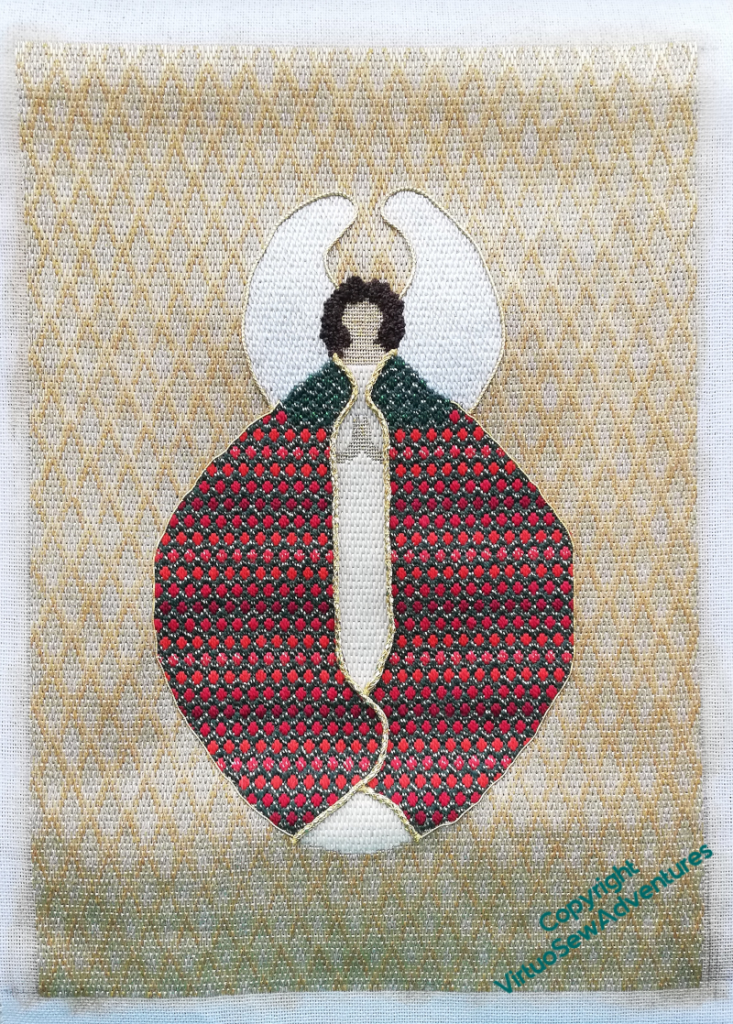
So here we are. All the gold canvaswork completed, the Angel outlined in different weights of thread, given tightly curled hair in French Knots, and now ready for however I work out how to mount her and turn her into something pleasing, and useful to decorate the house next Christmas.
I haven’t given the Angel a face, and I don’t think I will. It’s distressingly easy for “sweet” or “joyful” to become “disturbingly weird” with faces, especially when there is so little space, and relatively few stitches to manoevre with. If I experience an inspiration, I’ll reconsider, at least until I’ve mounted her. At the moment I’m looking for a sufficiently tall and wide cardboard tube that I can cut in half. Alternatively, I need to be very clever indeed about my card engineering…
It really only took as long as it did – it was begun in 2015 – largely because there was a lot of background, and it was remarkably tricky to find a rhythm to the pattern. Once I did so, it became much easier, and fairly romped away. Before that time, it spent a considerable period hidden away because – not having found the rhythm – it just made me grumpy to look at it!
Lorgnette Case Finished and Ready
The lorgnette case would have been finished more quickly had I not been using a corner of the same canvas I was doing the Fishy Experiments on!
When I’d bordered the scroll pattern, using a long armed cross stitch, I thought that maybe it wasn’t quite long enough, and added a square section to the top to act as a closing flap.
The next task was to cut it out, turn in the canvas and catch it down, and then line the piece with felt so that the interior doesn’t scratch the lenses of the lorgnettes. This is always rather fiddly, but a very necessary stage. I certainly wouldn’t want to try to add the felt without catching down the canvas separately!
The next thing was to turn the lined strip into the case. I’ve used the same variegated pearl cotton as I used for the border, and in effect, the same stitch. It goes forward two and back one, so the finished stitching creates much better coverage than a straight overcast stitch. It has a slight fishbone pattern, and you can continue on from the joining seam to run around the edge of the flap without even breaking stride, as it were.
Since there’s already colour variation in the yellow and the blue, minimising the textural variation by edging the flap with the same stitch as the case is closed with makes the whole thing pull together nicely.
It only took an afternoon or so to finish the case and install the lorgnettes, so they are now ready for those Happier Times I mentioned, when Museums and Menus are a regular part of life once more.
I should add that while I was at university, I was the girl who wore white gloves with her summer frocks. None of my friends will be at all surprised to find me wielding a pair of lorgnettes – in fact, if at least one of them doesn’t ask me what took so long, I will be rather surprised!
And now, the final (for now) episode of Slow TV Stitchery, Episode 73, in which the slips are at last applied, and Tynemouth Priory is Finished.
Fishy Lessons
So now, having finished my two fishie experiments (there may have been a third in the pipeline, but I’ve forgotten what it was!), what can I say I’ve learnt?
First, canvaswork stitches against the freeform bargello. There’s a sort of stillness, almost a static quality to this fish, in spite of the flowing bargello.
The bargello works well, although now I look at it, I’ve not managed to keep it flowing from top to bottom. And it was remarkably difficult to keep track of the pattern across the fish.
The second fish was an attempt to suggest the broken outline of an object seen through the interface between air and water. So this time, the pattern of the bargello ran through the fish, and I had to decide at each edge whether to stitch in the fish colour or the water colour. The pattern runs more successfully from top to bottom of the piece, but the whole thing looks a lot more active, maybe too active.
I think the colours are a bit too bright and swimming pool-like, but as these are experiments, using stash, I’m not too concerned about that. What does concern me is that even after these two, fairly substantial pieces, the appearance of a particular blend of threads as it was stitched was sometimes a surprise. It will be hard to pick the right colours to use if I can’t rely on my imagination of how the thread will stitch up.
So, I don’t know whether I will use this idea for the borders of Placidus, but I’ve got plenty to think about, haven’t I!
Episode 69 of Slow TV Stitchery is now live, on talking projects, the development of musical taste, and the challenges of suggesting wind over the water.
Tynemouth Priory
Now then, this is an old friend, and everyone who’s been following my SlowTV Stitchery will be aware that since this is the Year of Finishes, I’ve decided to finish it. This is the first “Tynemouth Priory”, which I started, only to decide that the colours were all wrong against the Flag Sunrise, and I had to start again. I’m glad I did, because the second version fitted into the complete “Leaving The Tyne, 1915” very much better than this one would have done.
However, when I came back to it and started stitching again, I realised that the variegated thread I was using in the cloud may have looked right in the skein, but it wasn’t right when it was stitched.
Sigh.
Time to channel my inner Penelope, and unravel at night everything I had worked during the day.
I picked out two slightly different pale cream stranded cottons to take the place of the variegated thread, and a stranded cotton in a slightly lighter blue than the coton a broder, to go near the horizon, and I’m now reinstating it, with interesting diversions to create cloud-like effects.
At this point I was still feeling very tentative, but I think the sky is improving as I progress across it!
Episode 60 of SlowTV Stitchery is now live. In which is considered making a virtue out of a necessity, arguments with the ghost of Miss Hunter, and a plea is made for an Introduction to the Picts, all supplemented with some meditations on literary sources for future projects.

